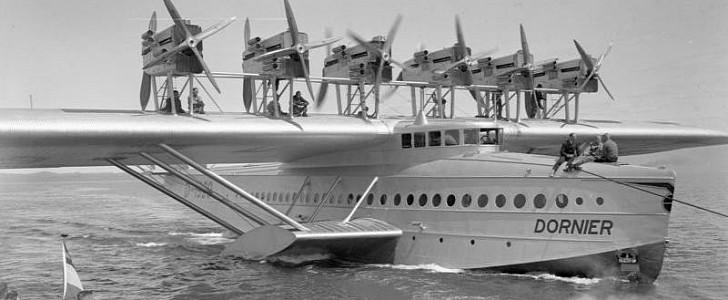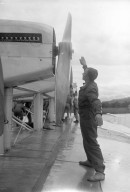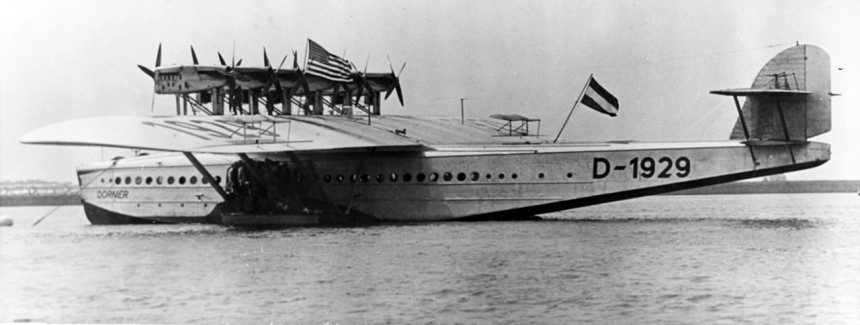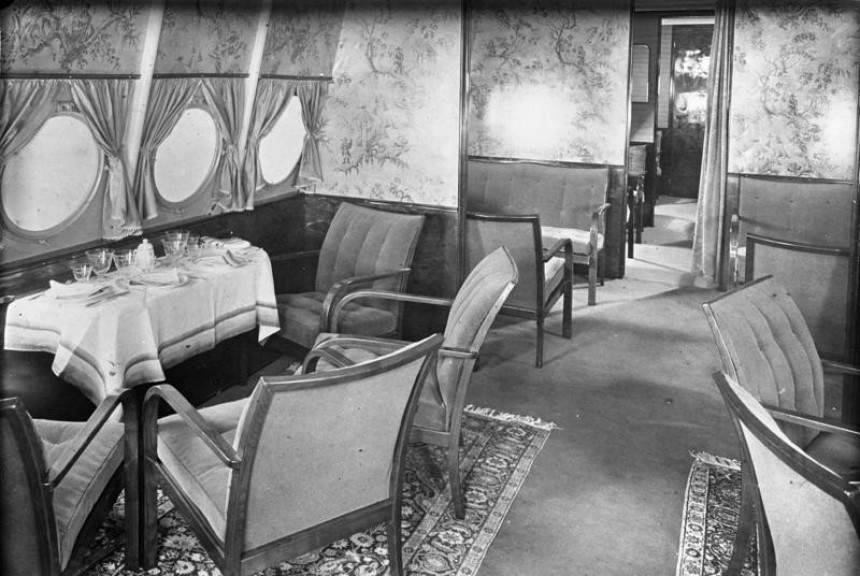In a previous piece here during Sea Month at autoevolution, we told the tale of a time before the era of colossal international airports. An era when water-bound flying boats were the preferred method of air travel. As Claude Dornier teaches us, the wide open sea leaves plenty of room for giant airplanes.
It was the German Dornier Flugzeugwerke company that constructed what was, at the time, the largest commercial airliner in the world. When we tell you this leviathan flying boat could carry a similar capacity of people as a modern widebody jetliner in the late 1920s, it's not hyperbole. It should come as no surprise that Claude Dornier was a pupil of Count Ferdinand von Zeppelin, the mastermind of the Zeppelin rigid airship.
Count Zeppelin had his bespoke philosophies for the solution of high-capacity intercontinental transit. But in hindsight, it's clear his protege's design language transferred better into what the future eventually held for the industry. An ostensibly non-politically motivated inventor, Claude Dornier, would later be pressured into joining the Nazi party in 1940 and was interrogated before being cleared of war crime-related wrongdoing in the aftermath of World War II.
But during the time of the interim Weimar Republic, Dornier was free to develop his ideas as he saw fit. His grand vision was a fleet of super-heavy flying boat airliners that could connect the hemispheres in ways not possible until the jet age 30 years later. But at its core, Dornier's semi-cantilever monoplane flying boat colossus had all the right ideas in mind.
The Do X's proportions are eerily similar to widebody jet airliners manufactured decades later. With dimensions of 40.05 meters (131 ft 5 in) long with a 47.8 meter (156 ft 10 in) wingspan, the Do-X's width matches that of a modern Boeing 767-300 to within mere inches.
With a gross weight of 49,000 kg (108,027 lb), the Dornier undercuts a modern jetliner by as much as 31,100 kg (68,650 lb). It owes this to a lightweight but durable hull made of a novel German-developed aluminum alloy called Duralumin. The Do-X's wings were also made of Duralumin, along with forged steel reinforcement bracing covered in a layer of fabric.
Unlike most flying boats, a pair of Duralumin winglets replaced traditional underwing floats to right the ship in the water. Powering this hulking beast initially was a compliment of 12x525 horsepower Siemens Jupiter nine-cylinder radial piston engines arranged in a push-pull arrangement in six separate nacelles overtop the wings. After its first flight on 12 July 1929, two more examples were ordered by Italian investors, bringing the total production to three.
The Do-X entered commercial limited passenger service in the fall of 1929. By October of that year, the seaplane was carrying stress test passenger loads as high as 169 people, a touch under two-thirds the seating capacity of the aforementioned 767-300. By late 1920s aviation standards, that may as well have been witchcraft.
When the dozen Jupiter engines failed to lift the first Do-X to a serviceable altitude, they were replaced with the same number of American 610 horsepower Curtiss V-1570 Conqueror V12s that could lift the massive vessel to a cruising height of 500 m (1,600 ft). Subsequent Italian-owned Do-Xs would sport Fiat A-22R V12 engines with relatively similar power figures.
The Do-X2, the Umberto Maddalena, and Do-X3, the Alessandro Guidoni, were touted as the largest, most luxurious airliners the world had ever seen. There was room for passengers' private sleeping quarters, a bar and lounge, a dining room, and a smoking room on board the plane's three decks. A complimenting crew of up to 14 people, including the pilot, co-pilot, and flight engineer, ensured everything ran smoothly.
By 1930, the first Do-X was flying for Deutsche Lufthansa on routes from Friedrichshafen in Germany across continental Europe to Lisbon, Portugal, before crossing the Atlantic. While in port, a freak accident fire left the ship stranded for waiting for repairs. It then continued its journey to the island country of Cape Verde off the coast of Northwest Africa before crossing the rest of the ocean to Natal, Brazil, and then San Juan, Puerto Rico.
After a publicity stop at the future LaGuardia Airport in New York City, the Do-X continued to Newfoundland, Canada, then the Azores, and finally back home to Germany. It was hoped wealthy passengers would pay top dollar for an aerial experience not too dissimilar to an ocean liner. Sadly, both the Do-X1 and Do-X2 suffered identical accidents in which their tail sections fell off during a hard landing within a month of each other.
Do-X1 was exhibited in a German museum before being destroyed during Allied bombing raids. The two Italian examples were mothballed and scrapped by 1937. Alas, Claude Dornier's dream of a flying boat empire largely died with the beginning of World War Two.
Check back soon for more from Sea Month here on autoevolution.
Count Zeppelin had his bespoke philosophies for the solution of high-capacity intercontinental transit. But in hindsight, it's clear his protege's design language transferred better into what the future eventually held for the industry. An ostensibly non-politically motivated inventor, Claude Dornier, would later be pressured into joining the Nazi party in 1940 and was interrogated before being cleared of war crime-related wrongdoing in the aftermath of World War II.
But during the time of the interim Weimar Republic, Dornier was free to develop his ideas as he saw fit. His grand vision was a fleet of super-heavy flying boat airliners that could connect the hemispheres in ways not possible until the jet age 30 years later. But at its core, Dornier's semi-cantilever monoplane flying boat colossus had all the right ideas in mind.
The Do X's proportions are eerily similar to widebody jet airliners manufactured decades later. With dimensions of 40.05 meters (131 ft 5 in) long with a 47.8 meter (156 ft 10 in) wingspan, the Do-X's width matches that of a modern Boeing 767-300 to within mere inches.
Unlike most flying boats, a pair of Duralumin winglets replaced traditional underwing floats to right the ship in the water. Powering this hulking beast initially was a compliment of 12x525 horsepower Siemens Jupiter nine-cylinder radial piston engines arranged in a push-pull arrangement in six separate nacelles overtop the wings. After its first flight on 12 July 1929, two more examples were ordered by Italian investors, bringing the total production to three.
The Do-X entered commercial limited passenger service in the fall of 1929. By October of that year, the seaplane was carrying stress test passenger loads as high as 169 people, a touch under two-thirds the seating capacity of the aforementioned 767-300. By late 1920s aviation standards, that may as well have been witchcraft.
When the dozen Jupiter engines failed to lift the first Do-X to a serviceable altitude, they were replaced with the same number of American 610 horsepower Curtiss V-1570 Conqueror V12s that could lift the massive vessel to a cruising height of 500 m (1,600 ft). Subsequent Italian-owned Do-Xs would sport Fiat A-22R V12 engines with relatively similar power figures.
By 1930, the first Do-X was flying for Deutsche Lufthansa on routes from Friedrichshafen in Germany across continental Europe to Lisbon, Portugal, before crossing the Atlantic. While in port, a freak accident fire left the ship stranded for waiting for repairs. It then continued its journey to the island country of Cape Verde off the coast of Northwest Africa before crossing the rest of the ocean to Natal, Brazil, and then San Juan, Puerto Rico.
After a publicity stop at the future LaGuardia Airport in New York City, the Do-X continued to Newfoundland, Canada, then the Azores, and finally back home to Germany. It was hoped wealthy passengers would pay top dollar for an aerial experience not too dissimilar to an ocean liner. Sadly, both the Do-X1 and Do-X2 suffered identical accidents in which their tail sections fell off during a hard landing within a month of each other.
Do-X1 was exhibited in a German museum before being destroyed during Allied bombing raids. The two Italian examples were mothballed and scrapped by 1937. Alas, Claude Dornier's dream of a flying boat empire largely died with the beginning of World War Two.
Check back soon for more from Sea Month here on autoevolution.

























